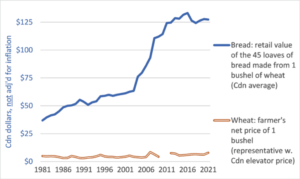In 2022, it’s expected that people in Canada will pay between 5 and 7 per cent more for groceries, an increase of close to $1,000 a year for a family of four.
That is a noticeably high increase which will hit many families, lower-income earners, and those on fixed incomes hard.
This increase follows a similar increase in 2021, which saw a family of four in Canada paying close to $700 more that year for food, an increase of 4 per cent overall.
The reasons for the food cost increases are likely not news for most readers. We have long heard, since the beginning of the pandemic, about transportation issues, supply chain disruptions, labour market shortages, high inflation, and now issues related to climate change.
In the 12th edition of the annual Canada’s Food Price Report released for 2022, the estimated increases are detailed by food category. Compiled by Dalhousie University, Guelph University and this year for the first time the universities of Saskatchewan and British Columbia, the report assesses trends, costs, and impacts across the sector. The report also includes forecasts by province. And the report can be trusted, having accurately predicted food price increases in ten of the last 11 years.
Since 2020 of course the report has factored in the impact of COVID-19 on food prices and food insecurity. But the reality is that even before this pandemic, food prices in Canada increased by 70 per cent between 2000 and 2020. Tally that up in terms of annual averages and food prices in this country during the same period rose between 6 to 7 per cent every year. And while for a time people in Canada spent a stable 10 per cent of their income on food, that percentage has been growing. Between 2015 and 2019, the median income grew by 6.6 per cent. Meanwhile, food expenditures rose close to three times more — 16.3 per cent.
In 2019, when food expenditures were measured by the Global Food Security Index, Canada ranked 18th. Canada now ranks 24th in the world. With near stagnant wages, people in Canada can expect a larger share of their income to be spent on food going forward. And, as noted, those earning the least will be the most affected by food price increases, as will people living in more remote communities, such as northern Canada.
Meanwhile, what the report does not measure in any way, is how this food inflation is impacted by the price that farmers receive at the farmgate for everything from wheat for flour to pork or beef.
So how are our family farmers doing? Have the price of their products added to these price increases?
The National Farmers Union (NFU) recently released information showing that food price increases cannot be attributed to either the pandemic or to increases in prices paid to farmers. The information released by the NFU includes several telling charts documenting prices paid to farmers in Canada for wheat, pork, and other meat products. The charts are telling.
“Consumers need to know that less and less of the money they spend on food actually makes it back to the farmer,” said NFU Vice-President of Operation and Saskatchewan farmer, Stewart Wells, in a recent media release. “Retail food prices are high because meat packers, other large processors, and big retailers are taking ever larger shares. For most food products, the farmers’ share continues to shrink.”
Wells added, “Big processors, packers, and retailers are charging consumers more, paying farmers as little as possible, suppressing workers’ wages, and taking more for themselves.”

So then, the rise in food prices cannot be attributed to increases in grain or livestock prices, supply issues, or COVID-19, he noted.
If you consider the food price trends outlined in Canada’s Food Price Report 2022 and the information provided by the NFU relative to farm incomes, the picture becomes clearer.
Now compare these price increases to what has been happening with Canadian CEOs during this pandemic.
Consider Another year in paradise — CEO pay in 2020 published in January by the Canadian Centre on Policy Alternatives and the injustices accumulate yet further.
The report’s author, David Macdonald, writes, “The year 2020 might have been a bad one thanks to the COVID-19 pandemic, but for top CEO pay in Canada, it was another year in paradise. Despite the pandemic, the highest-paid 100 CEOs of Canada’s largest companies got paid an average $10.9 million in 2020, which is $95,000 more than what they were paid in 2019.”
The report details the salaries and bonuses of the top 100 CEOs in Canada – among these are George Weston Ltd. and Maple Leaf Foods. So, guess who is taking the bread, and the pork, and the beef!
The report goes on to document the salaries, the bonus loopholes used to help CEOs avoid paying taxes, and the shamelessness that has allowed some of the companies, led by these same CEOs, to actually profit throughout the pandemic from various federal government programs. Not all of the 100 companies cashed in on support programs, but an astounding number of 35 companies actually applied for and received the Canada Emergency Wage Subsidy, which the report notes did not actually have to go to workers’ wages. Although one might argue that the CEO “workers” might have actually benefited.
And it appears that Canada is not alone in allowing this type of profiteering from our richest CEOs.
Check out the just released report by Oxfam International, Inequality Kills, calling on the governments of the world to impose a one-off 99% wealth tax on windfall profits from COVID-19. The 10 richest billionaires on earth have been getting richer by $1.3 billion a day, much of it by cashing in government support programs, while the World Bank estimates that 163 million more people have been driven into poverty.
In releasing its report, Oxfam stated, “The world’s ten richest men more than doubled their fortunes from $700 billion to $1.5 trillion–at a rate of $15,000 per second or $1.3 billion a day — during the first two years of a pandemic that has seen the incomes of 99 percent of humanity fall and over 160 million more people forced into poverty.”
And so we see who is stealing the bread….not just here in Canada but right around the world.



